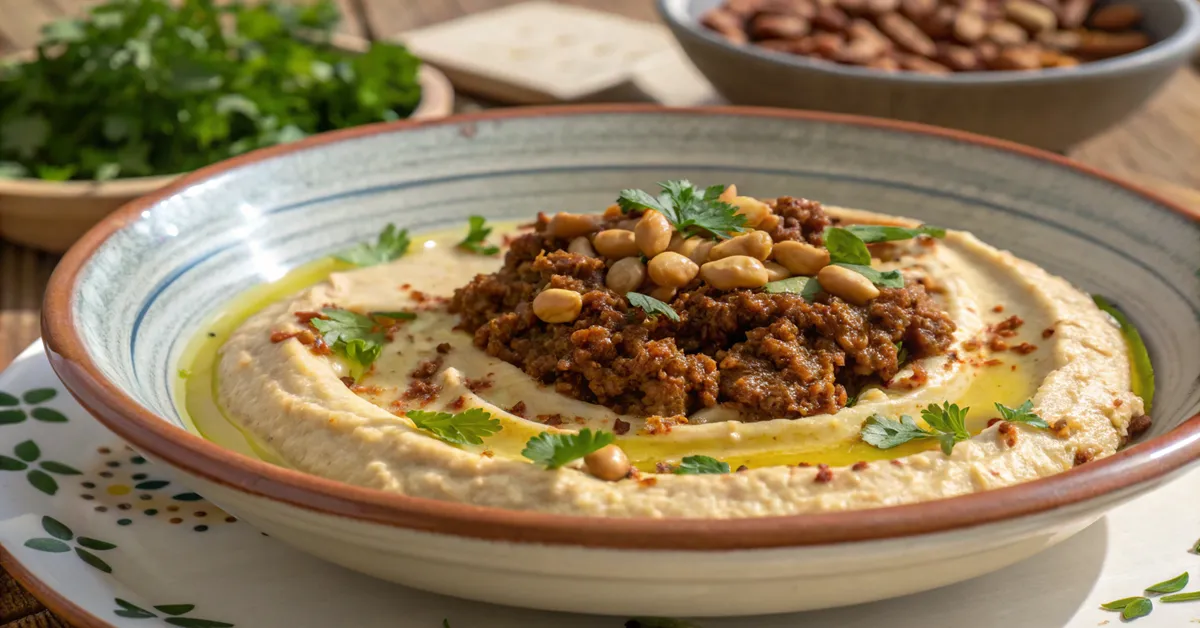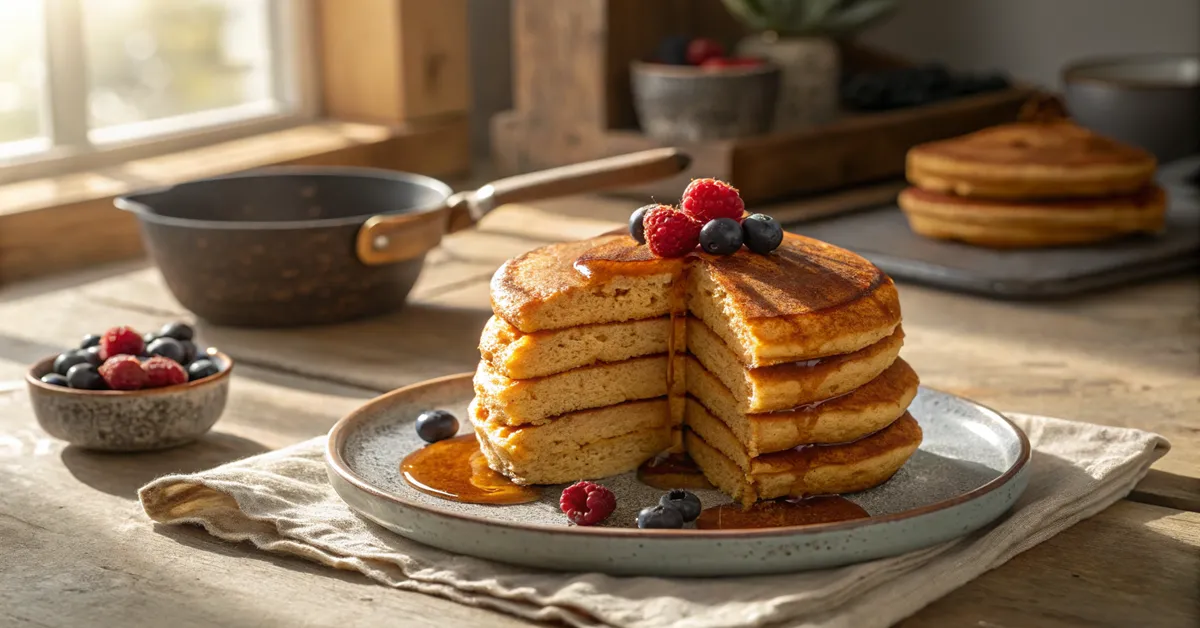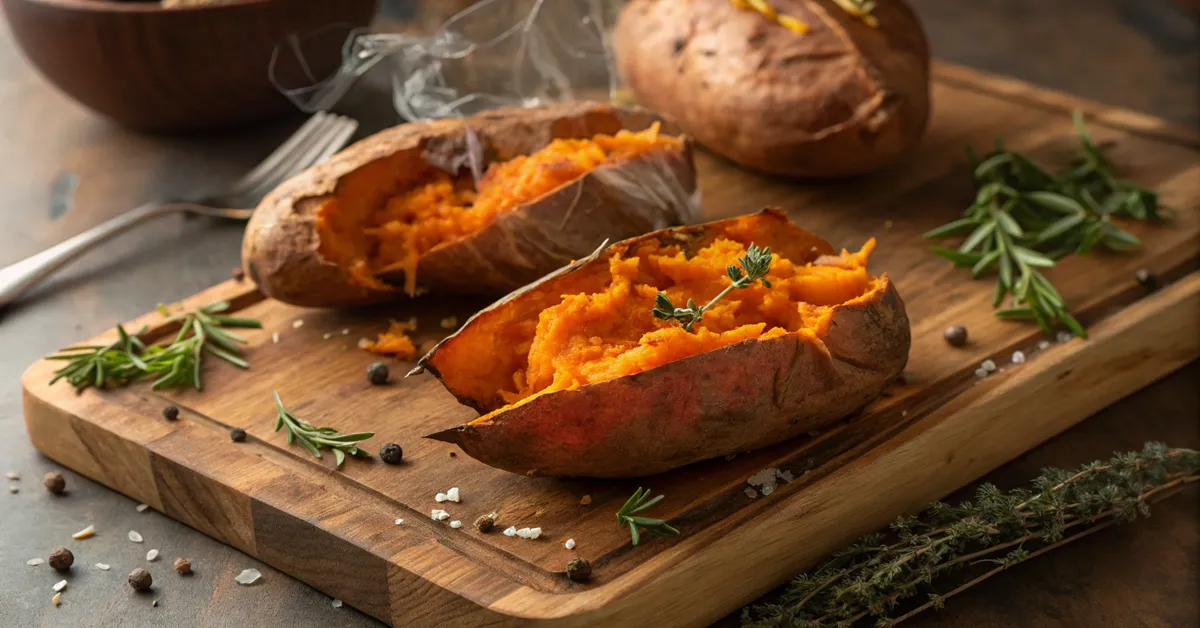Hummus bil Lahme Recipe: Your Best Guide to Middle Eastern Flavors
Hummus bil Lahme is more than just a simple dish; it’s a celebration of Middle Eastern tradition, flavors, and hospitality. This Lebanese-Syrian classic transforms humble chickpeas into a creamy, savory base, crowned with spiced, sautéed meat and a sprinkle of golden pine nuts. Known as a staple in Levantine cuisine, it’s loved for its bold taste, easy preparation, and the way it brings people together at the table. Whether you’re hosting a dinner party, planning a mezze spread, or craving authentic flavors, this comprehensive guide to Hummus bil Lahme will walk you through everything — from ingredients to plating and even the cultural significance behind this iconic dish.
Table of Contents
Table of Contents
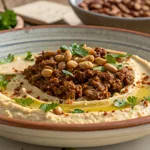
Hummus bil Lahme Recipe: The Ultimate Guide to Middle Eastern Flavors
- Total Time: 45 minutes
- Yield: 6 servings
Description
Hummus bil Lahme is a traditional Middle Eastern dish that pairs silky, homemade hummus with a generous topping of spiced ground meat, toasted pine nuts, and fresh parsley. Perfect for mezze spreads or as a hearty appetizer, this dish embodies the authentic flavors of Lebanese and Syrian cuisine in every bite.
Ingredients
Ingredients
2 cups hummus bi tahini (prepared or store-bought)
1 lb ground beef or lamb
1 tbsp Baharat (Lebanese seven spice)
1 medium sweet onion, finely diced
6 cloves garlic, finely chopped
3 tbsp olive oil
1/4 cup toasted pine nuts
Fresh parsley, chopped (for garnish)
Salt to taste
Aleppo pepper or sumac (optional, for garnish)
Instructions
Step By Step Instructions
Prepare the Hummus:
Blend cooked chickpeas with tahini, lemon juice, garlic, and olive oil until smooth. Adjust seasoning with salt and cumin. Set aside.Cook the Lahme Topping:
In a skillet, heat olive oil and sauté diced onions until soft. Add garlic, cook until fragrant. Mix in ground meat and cook until browned. Stir in Baharat spice and season with salt.Toast Pine Nuts:
In a separate pan, toast pine nuts over medium heat until golden brown.Assemble the Dish:
Spread hummus on a serving plate, creating a well in the center. Spoon the hot lahme mixture into the well. Top with toasted pine nuts and sprinkle fresh parsley.- Serve:
Drizzle with olive oil, garnish with sumac or Aleppo pepper if desired. Serve with pita or fresh vegetables.
Notes
- For a vegetarian version, substitute ground meat with plant-based crumbles and Baharat seasoning.
- Serve warm with pita bread or fresh vegetables.
- Adjust garlic and lemon levels in hummus according to taste preference.
- Freshly toasted pine nuts add texture and a buttery finish.
- Prep Time: 30 minutes
- Cook Time: 15 minutes
- Category: Mediterranean Dinner Recipes
- Method: Blending, Sautéing
- Cuisine: Mediterranean
Nutrition
- Serving Size: 1 portion (approx. 200g)
- Calories: 430 kcal
- Sugar: 2 g
- Sodium: 310 mg
- Fat: 28 g
- Saturated Fat: 6 g
- Unsaturated Fat: 20 g
- Trans Fat: 0 g
- Carbohydrates: 18 g
- Fiber: 5 g
- Protein: 22 g
- Cholesterol: 55 mg
What is Hummus bil Lahme?
The Origins of Hummus bil Lahme in Middle Eastern Cuisine
Hummus bil Lahme literally translates to “hummus with meat” in Arabic, a phrase that perfectly sums up the dish’s essence. Rooted in Levantine countries like Lebanon, Syria, and Palestine, this savory appetizer doubles as a hearty meal. Unlike the traditional hummus served as a cold dip, Hummus bil Lahme layers seasoned ground beef or lamb over a smooth hummus base. The dish is traditionally topped with toasted pine nuts and fresh parsley, making it a visually stunning and flavor-packed centerpiece of any mezze platter.
The origins of hummus itself trace back centuries, with contested claims among several Middle Eastern nations. However, the addition of lahme (meat) is strongly tied to Lebanese and Syrian culinary traditions, where rich flavors and layered textures define much of their cuisine. In Damascus, Beirut, and Aleppo, this dish often graces family gatherings, restaurants, and special occasions, celebrated for its simplicity and deep flavors.
Traditional Lebanese and Syrian Influence on Hummus Recipes
In both Lebanese and Syrian households, hummus is not just a condiment; it represents a vital part of their cultural heritage. Families have their distinct methods of preparation, typically shared across generations. The Lebanese variant focuses on a refreshing, tangy profile with a creamy consistency, while the Syrian style incorporates deeper, earthy notes enhanced by garlic and cumin.
Hummus bil Lahme is a perfect example of how these regional nuances come together. In Lebanon, it’s common to use Baharat — the famed Lebanese seven spice — in the ground meat, giving it a rich, aromatic profile. Syrian versions might introduce Aleppo pepper for a touch of heat or pine nuts for added crunch and luxury. These subtle differences showcase the diverse ways Middle Eastern cultures adapt the same basic recipe into something uniquely their own.
Check out this hummus twist: Chimichurri Hummus
Ingredients Breakdown of Authentic Hummus bil Lahme
Key Ingredients: Chickpeas, Tahini, and Spices
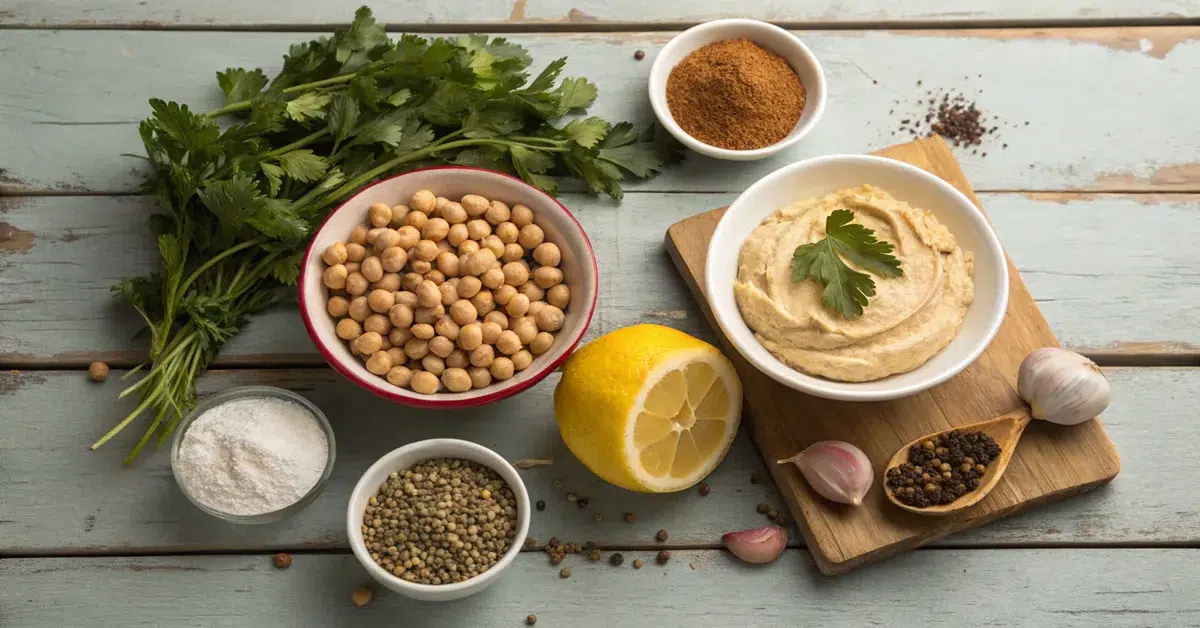
At the heart of every authentic Hummus bil Lahme lies a carefully chosen selection of fresh, quality ingredients. Let’s break them down.
Chickpeas (Garbanzo Beans):
As the core ingredient in hummus, chickpeas contribute a velvety texture and a subtle nutty taste when they are properly prepared.Traditional recipes call for dried chickpeas soaked overnight, ensuring a soft, velvety consistency. However, high-quality canned chickpeas are an acceptable shortcut when time is tight.
Tahini (Sesame Paste):
Tahini, made from finely ground sesame seeds, is essential for creating a silky hummus texture, lending a rich depth and a subtle bitterness that harmonizes beautifully with lemon and garlic. Always choose premium tahini — look for smooth, pourable varieties with a mild taste.
Lemon Juice:
Freshly squeezed lemon juice brightens the hummus and cuts through the richness of the tahini and meat. It enhances the overall flavor profile and keeps the dish feeling fresh.
Garlic:
Raw garlic is often blended directly into the hummus, delivering a pungent bite. To soften the sharpness, some chefs soak chopped garlic in lemon juice before blending.
Ground Cumin:
A fundamental spice in Middle Eastern dishes, cumin elevates the earthy notes of chickpeas, providing a rich complexity to the hummus.
Olive Oil:
A splash of high-quality extra virgin olive oil brings all the elements together in perfect harmony. It’s used both in the hummus mixture and as a garnish on top before serving.
Choosing the Right Meat for Lahme Hummus
The defining feature of Hummus bil Lahme is its savory topping of spiced ground meat. Here’s what you need to know:
Ground Beef or Lamb:
Both meats are traditionally used in this dish. Ground lamb offers a more authentic, slightly gamey flavor, while beef is a milder option appreciated for its wide appeal. For the best texture, choose a medium-fat grind.
Baharat (Lebanese Seven Spice):
This essential spice blend gives the meat its signature taste. The typical mix includes black pepper, paprika, cumin, coriander, cloves, cinnamon, and nutmeg — creating a warm, aromatic profile that pairs beautifully with hummus.
Toasted Pine Nuts:
These golden gems are sprinkled over the finished dish, adding a buttery crunch. They not only enhance the flavor but also elevate the presentation.
Fresh Parsley:
A simple garnish of chopped parsley adds color and a fresh, herbaceous note to the dish.
Salt and Aleppo Pepper:
Salt enhances the natural flavors of the meat, while Aleppo pepper adds a mild warmth and a hint of fruitiness, making it a beloved ingredient in Syrian cooking.
Looking for inspiration? Try: Moroccan Fish in 4 Simple Steps
How to Make Creamy Hummus Base at Home
Cooking Dried Chickpeas vs Using Canned Chickpeas
One of the secrets behind irresistibly creamy hummus is starting with the right chickpeas and preparing them correctly. Here’s how you can make your base just like the Lebanese and Syrian kitchens do.
Using Dried Chickpeas:
Dried chickpeas require soaking overnight in plenty of water with a touch of baking soda. This softens their skins, making them easier to cook and blend. After soaking, simmer the chickpeas until they’re very soft — you should be able to mash them easily with your fingers. This method gives you a superior texture and richer flavor.
| Step | Action |
| 1 | Soak 16 oz dried chickpeas with 1 tbsp baking soda overnight |
| 2 | Drain and rinse thoroughly |
| 3 | Boil until tender (about 60–90 mins) |
| 4 | Skim off floating skins and impurities |
| 5 | Reserve some cooking water for blending |
Using Canned Chickpeas:
Short on time? You can use canned chickpeas. Simply drain, rinse, and boil them for about 15–20 minutes with a pinch of baking soda. This step softens the skins and warms them up, which helps the blending process. After boiling, rub them gently between your hands in a bowl of water to remove the skins for a smoother hummus.
| Step | Action |
| 1 | Drain and rinse two cans of chickpeas |
| 2 | Boil with baking soda for 15–20 minutes |
| 3 | Rinse and peel skins if possible |
Don’t miss our gluten-free ideas: 10 Gluten-Free Mediterranean Recipes
Secrets to Creamy Texture: Tahini, Lemon, Garlic Balance
Even with perfectly cooked chickpeas, creamy hummus depends on balancing flavors and textures in the blending process.
Use Ice-Cold Water or Chickpea Cooking Water:
Adding a little at a time while blending loosens the mixture without making it watery. Using cold water to blend the tahini creates an airy and smooth hummus.
Blend in Stages:
- First, puree the garlic and lemon juice together and let it sit for 10 minutes.
- Add tahini and blend until thick and creamy.
- Finally, add chickpeas and slowly drizzle in cold water or aquafaba.
Tahini to Chickpeas Ratio:
The perfect ratio is typically 1/3 cup tahini to every 2 cups of cooked chickpeas, adjusted based on your preferred creaminess.
Season Generously:
Don’t shy away from salt, cumin, and a generous squeeze of lemon. Taste as you go and adjust accordingly.
Drizzle Olive Oil at the End:
A final swirl of high-quality olive oil before serving brings everything together with a luscious finish.Discover this nutritious breakfast choice: Spinach and Mushroom Omelette
Preparing the Perfect Lahme Topping for Hummus bil Lahme
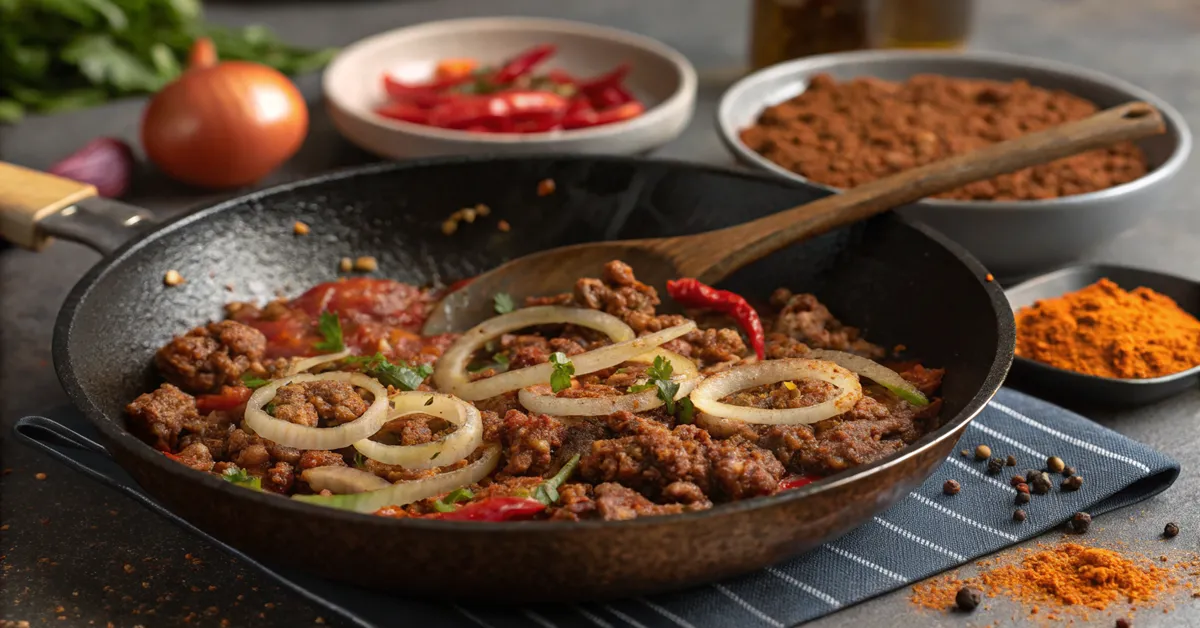
Using Lebanese Seven Spice (Baharat) for Flavorful Meat
Hummus bil Lahme wouldn’t be complete without its signature lahme topping — spiced, tender ground meat that infuses the dish with warmth and depth. The authentic preparation begins with selecting high-quality ground meat and infusing it with Lebanese flavors.
Baharat: The Essential Spice Blend
The essence of delicious lahme in hummus bil lahme comes from Lebanese seven spice, also known as Baharat. This traditional blend often includes black pepper, cinnamon, cumin, cloves, nutmeg, coriander, and paprika. Its aromatic complexity transforms simple ground meat into a topping bursting with Middle Eastern flair.
In hummus bil lahme, Baharat transcends mere seasoning; it transforms the dish entirely. When the ground beef or lamb is sautéed with onions, garlic, and Baharat, it creates a savory, slightly sweet, and spicy profile that complements the creamy hummus base.
| Baharat Ingredients | Flavor Note |
| Black Pepper | Warm, pungent |
| Cinnamon | Sweet, aromatic |
| Cumin | Earthy, nutty |
| Cloves | Sweet-spicy |
| Nutmeg | Warm, sweet |
| Coriander | Citrusy |
| Paprika | Mild heat |
Making Your Own Baharat for Hummus bil Lahme:
If you can’t find Baharat at your local store, mix equal parts of the spices listed above. This ensures your hummus bil lahme captures that authentic Lebanese touch.
Cooking Techniques for Tender Ground Beef or Lamb
Start with Sautéed Aromatics:
Heat a skillet and pour in some olive oil, then cook the finely chopped onions until they are tender and golden brown. This forms the flavor base of the lahme for your hummus bil lahme.
Add Garlic for Depth:
Garlic should be added once the onions soften. Cook slowly over low heat to prevent burning and enhance its natural sweetness.
Season Generously with Baharat and Salt:
Incorporate a heaping tablespoon of Baharat along with a dash of sea salt. This allows the meat to soak up all the flavors, ensuring your hummus bil lahme is truly memorable.
Cook Until Just Done:
Overcooking the meat can make it dry. Cook the lahme until it’s browned and fully cooked but still moist.
Toast Pine Nuts Separately:
In a small skillet, lightly toast pine nuts until they turn a rich golden brown. This step, though simple, adds a crunchy, buttery contrast to the warm lahme topping of your hummus bil lahme.
Assembly Tip:
When serving, create a well in the hummus, spoon the hot lahme in the center, and garnish with pine nuts and fresh parsley. The contrast between the warm meat and cool, creamy hummus defines the essence of hummus bil lahme.Discover great ideas like: Vegan Lemon Olive Oil Cake
Plating and Serving Hummus bil Lahme Like a Pro
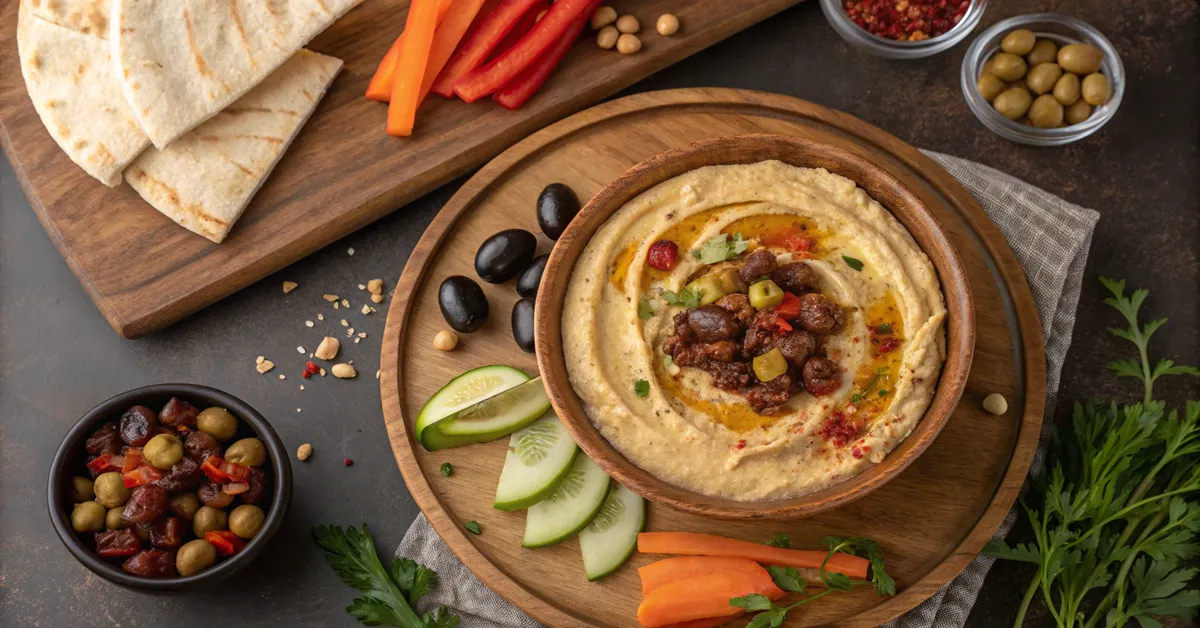
Creating the Classic Hummus Well Presentation
How you serve hummus bil lahme holds as much significance as the way you make it. The traditional presentation of hummus bil lahme transforms this dish from a simple dip into a show-stopping centerpiece on any Middle Eastern table.
Start with a Wide Serving Dish:
Spread the creamy hummus in a circular motion using the back of a spoon. The goal is to create a thick, even layer of hummus across the dish — a signature look for authentic hummus bil lahme.
Make the Classic Hummus Well:
Using your spoon, softly push down the center to shape a slight well. This iconic step holds the hot, savory lahme topping in place and highlights the contrast between the smooth hummus and the spiced meat. The hummus well is a classic feature in almost every hummus bil lahme presentation.
Warm Hummus for Serving:
Unlike traditional cold hummus, many prefer hummus bil lahme served slightly warm or at room temperature. It enhances the blend of flavors when the meat is spooned on top.
Toppings and Garnishes: Pine Nuts, Parsley, Sumac
Generous Pine Nut Garnish:
Toasted pine nuts add a crunchy, buttery layer that perfectly complements the savory lahme in your hummus bil lahme. Sprinkle them liberally over the meat for an authentic touch.
Fresh Parsley:
A sprinkling of finely chopped parsley gives your hummus bil lahme a fresh, vibrant finish. The green contrasts beautifully with the golden pine nuts and rich meat.
Sumac or Aleppo Pepper:
Sprinkle a touch of sumac on top of your hummus bil lahme for a vibrant splash of color and a refreshing citrus flavor. Aleppo pepper is also a great choice for a mild heat that doesn’t overpower the dish.
Drizzle of Olive Oil:
Finish with a swirl of the finest extra virgin olive oil. It enhances the flavor and gives the hummus bil lahme a glossy, mouth-watering appearance.
Serving Suggestions:
- Serve with warm pita bread or freshly baked flatbread.
- Pair it with pickled veggies or a fresh side salad to create a well-rounded meal.
- Offer as part of a mezze spread alongside dishes like baba ganoush or tabbouleh.
Check out: 10 Gluten-Free Mediterranean Recipes
Popular Middle Eastern Dips and How Hummus bil Lahme Stands Out
Comparing Hummus, Mutabbal, Baba Ganoush, and Labneh
The Middle Eastern mezze table is famous for its vibrant array of dips, each carrying its distinct flavor and texture. Among them, hummus bil lahme holds a special place as a dish that perfectly merges creamy smoothness with rich, savory toppings.
Hummus:
The base for hummus bil lahme is classic hummus — a blend of chickpeas, tahini, garlic, lemon juice, and olive oil. It’s mild, creamy, and serves as the perfect canvas for additional flavors like lahme.
Mutabbal:
Often mistaken for baba ganoush, mutabbal is a smoky eggplant dip blended with tahini, garlic, and lemon. Unlike hummus bil lahme, it doesn’t use chickpeas and has a distinct smoky flavor that’s missing from the rich meat topping of hummus bil lahme.
Baba Ganoush:
A chunkier cousin of mutabbal, baba ganoush incorporates diced vegetables and sometimes pomegranate molasses. It’s more rustic and less creamy than hummus bil lahme, making it a different textural experience.
Labneh:
This luscious strained yogurt dip offers a delightful tang and is typically topped with olive oil and za’atar for added flavor. While creamy like hummus, labneh is lighter and served cold, without the hearty meat topping that defines hummus bil lahme.
Why Hummus with Meat is a Mezze Favorite
Hummus bil lahme stands out because it blurs the lines between appetizer and main dish. Unlike traditional dips meant for nibbling, hummus bil lahme is hearty enough to satisfy as a standalone meal. The addition of seasoned ground meat transforms simple hummus into a protein-rich, savory delight.
Perfect Balance of Creamy and Savory:
The creaminess of the hummus base complements the spiced lahme perfectly. This balance is what elevates hummus bil lahme from a simple dip to a star dish on the mezze table.
A Mezze Dish with Depth:
Whereas other dips like mutabbal and labneh are often sides or starters, hummus bil lahme carries enough weight to be a centerpiece. It’s a conversation starter at gatherings and a staple at traditional Middle Eastern feasts.
Best with Fresh Bread and Good Company:
Hummus bil lahme shines when scooped up with warm pita bread and shared among friends and family — a true reflection of Middle Eastern hospitality.
Looking for inspiration? Try: Moroccan Fish in 4 Simple Steps
Health Benefits of Hummus and Its Nutritional Value
Is Hummus Healthy for Everyone?
Hummus, especially when prepared as hummus bil lahme, is more than just a flavorful dish — it offers genuine health benefits rooted in its natural ingredients. But is hummus bil lahme a healthy choice for everyone?
Rich in Plant-Based Protein:
The chickpeas in hummus bil lahme are a fantastic source of plant-based protein, making the dish ideal for vegetarians when prepared without meat. For those enjoying hummus bil lahme with traditional lahme topping, the combination of chickpeas and meat boosts the protein content significantly, supporting muscle repair and energy.
Packed with Dietary Fiber:
Chickpeas offer a generous dose of dietary fiber. This not only promotes healthy digestion but also assists in maintaining stable blood sugar levels. This dish of hummus bil lahme serves as a nourishing meal that supports digestive health and satisfies your culinary cravings..
Healthy Fats from Tahini and Olive Oil:
Tahini and olive oil are both abundant in monounsaturated fats, which are beneficial for cardiovascular health. Including them in hummus bil lahme provides essential fatty acids that help reduce bad cholesterol.
Lahme Adds Essential Iron and B Vitamins:
When beef or lamb is used in hummus bil lahme, it enhances the dish’s nutritional profile by contributing iron, zinc, and B vitamins. These nutrients are crucial for maintaining healthy blood cells and boosting energy.
Protein, Fiber, and Healthy Fats Explained
| Nutrient | Source in Hummus bil Lahme | Health Benefit |
| Protein | Chickpeas, Lahme | Muscle support, satiety |
| Fiber | Chickpeas | Digestion, blood sugar control |
| Healthy Fats | Tahini, Olive Oil | Heart health, cholesterol balance |
| Iron & B Vitamins | Lahme | Energy, blood health |
Moderation is Key:
While hummus bil lahme is nutrient-dense, it’s also calorie-rich due to tahini, olive oil, and the meat topping. Enjoying hummus bil lahme as part of a balanced diet ensures you reap the health benefits without overindulging.
Perfect for a Mediterranean Diet:
Hummus bil lahme fits naturally into the Mediterranean diet — known for its heart health benefits. When paired with whole-grain pita and fresh vegetables, hummus bil lahme makes for a wholesome, balanced meal.Check out: Mediterranean Salmon Bowl Guide
Cultural Traditions and Serving Customs for Hummus bil Lahme
What Do Arabs Dip in Hummus? Common Pairings and Breads
For Middle Eastern cultures, food represents more than just nutrition — it embodies connection. Hummus bil lahme beautifully illustrates a dish that fosters togetherness, especially during family reunions, Ramadan iftars, or relaxed social events.So, what do Arabs typically dip into their hummus, especially when it’s served as hummus bil lahme?
Warm Pita Bread:
The classic pairing for hummus bil lahme is fresh, fluffy pita bread. Warm pita is torn into pieces and used to scoop up the creamy hummus and savory lahme topping in perfect bites.
Khubz (Arabic Flatbread):
Khubz, a traditional Arabic flatbread, is another favorite for dipping. Its soft, airy texture complements the rich flavors of hummus bil lahme.
Fresh Vegetables:
Typical accompaniments on a mezze platter featuring hummus bil lahme include sliced cucumbers, radishes, carrots, and bell peppers. They offer a fresh, crisp contrast to the creamy and hearty dish.
Crispy Pita Chips:
For a modern twist, crispy pita chips are often served alongside hummus bil lahme at casual gatherings. They add a crunchy element to the experience.
How Muslims and Middle Eastern Families Enjoy Hummus
Hummus bil lahme holds a cherished place on the Middle Eastern table. Here’s how it’s woven into cultural and religious practices:
During Ramadan:
Hummus bil lahme is a favored option for iftar, the meal that ends the daily fast during Ramadan. Its balance of protein, fiber, and healthy fats makes it a nourishing option after a long day of fasting.
At Family Gatherings and Feasts:
No Middle Eastern feast feels complete without a dish of hummus bil lahme at the center. It symbolizes generosity and hospitality, often served to guests with a variety of breads and pickled vegetables.
As a Mezze Dish:
In the Levantine tradition, hummus bil lahme is a key part of the mezze — an assortment of small dishes served before the main course. It invites sharing, discussion, and the joy of communal eating.
Can Muslims Eat Hummus bil Lahme?
Muslims can savor hummus bil lahme as long as the meat is halal. The dish’s simple, wholesome ingredients make it a common and beloved choice in Muslim households across the Middle East.Looking for inspiration? Try: Chimichurri Hummus
What is Lahme Hummus?
More commonly referred to as hummus bil lahme, lahme hummus is a classic Middle Eastern dish that features a base of creamy hummus topped with spiced ground meat—usually beef or lamb—and garnished with toasted pine nuts and fresh parsley. In contrast to regular hummus, hummus bil lahme is distinguished by its robust flavors and substantial nature, often served as a main course or as a highlight of a mezze platter. The term ‘lahme’ translates to ‘meat’ in Arabic, adding protein, flavor, and richness to this filling and delightful meal.
What Do Syrians Call Hummus?
In Syrian cuisine, what we call hummus is referred to as ‘hummus,’ a term that originates from the Arabic word for chickpeas. When discussing the variation that includes meat, Syrians often use the terms “hummus ma’ lahme” or “hummus bil lahme,” highlighting the savory ground meat topping. Regardless of the terminology, this creamy chickpea dip adorned with spiced meat is a cherished staple in Syrian cuisine, particularly during family gatherings and celebrations.
What Do Arabs Dip in Hummus?
When enjoying hummus bil lahme, Arabs typically dip warm pita bread, khubz, or fresh vegetables like cucumbers, carrots, and radishes. The creamy texture of hummus bil lahme pairs perfectly with soft breads and crunchy veggies, making it a versatile dish for both casual snacks and formal gatherings. The lahme topping in hummus bil lahme enhances every bite, turning a simple dip into a hearty treat.
Can Muslims Eat Hummus?
Absolutely! Muslims can enjoy hummus—and specifically hummus bil lahme—as long as the meat included is halal. Hummus itself is a plant-based dish that is suitable for both vegetarians and vegans. When it comes to hummus bil lahme, it is crucial to use lahme sourced from halal-certified suppliers. Due to its nutritious ingredients and halal-compliant nature, hummus bil lahme is frequently found in many Muslim homes.
Is Arabic Hummus Healthy?
Hummus, particularly when served as hummus bil lahme, is viewed as a healthy alternative as long as it is consumed in moderation. The chickpeas, tahini, and olive oil offer essential nutrients like plant-based protein, healthy fats, and fiber. The lahme found in hummus bil lahme provides essential iron, zinc, and protein, contributing to its status as a balanced and wholesome dish. As with any food, enjoying hummus bil lahme as part of a varied diet ensures you get the benefits without excess calories.
What is the Lebanese 7 Spice?
Lebanese 7 spice, known as Baharat, is a fragrant blend of ground spices commonly used in Lebanese and Middle Eastern cooking. For hummus bil lahme, this spice mix is essential. It typically contains black pepper, cinnamon, cumin, coriander, cloves, nutmeg, and paprika. The seven spice blend gives the lahme in hummus bil lahme its warm, aromatic flavor that perfectly complements the creamy hummus base.
Conclusion: Why Hummus bil Lahme Should Be Your Next Middle Eastern Dish
Hummus bil lahme is far more than just a dish; it is a culinary custom that encapsulates the spirit of Middle Eastern hospitality. With its creamy chickpea base complemented by a richly spiced lahme topping, every bite of hummus bil lahme delivers a unique combination of flavors and textures that define Levantine cuisine. Whether served as a centerpiece in a mezze assortment, as a main course, or during festive occasions, hummus bil lahme brings people together in celebration.
Made from simple, wholesome ingredients and offering endless options for pairing, hummus bil lahme is a staple in any Mediterranean-inspired kitchen. Its perfect balance of creamy, savory, and fresh elements transforms hummus bil lahme into not just a dish, but a delightful experience to share with loved ones.
Don’t miss our gluten-free ideas: 10 Gluten-Free Mediterranean Recipes

